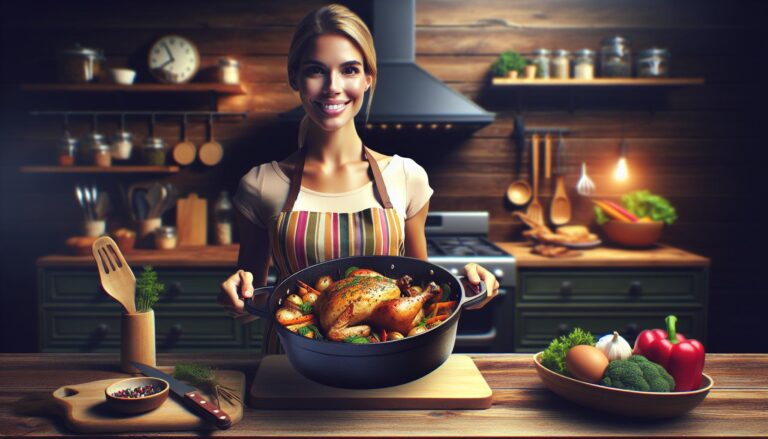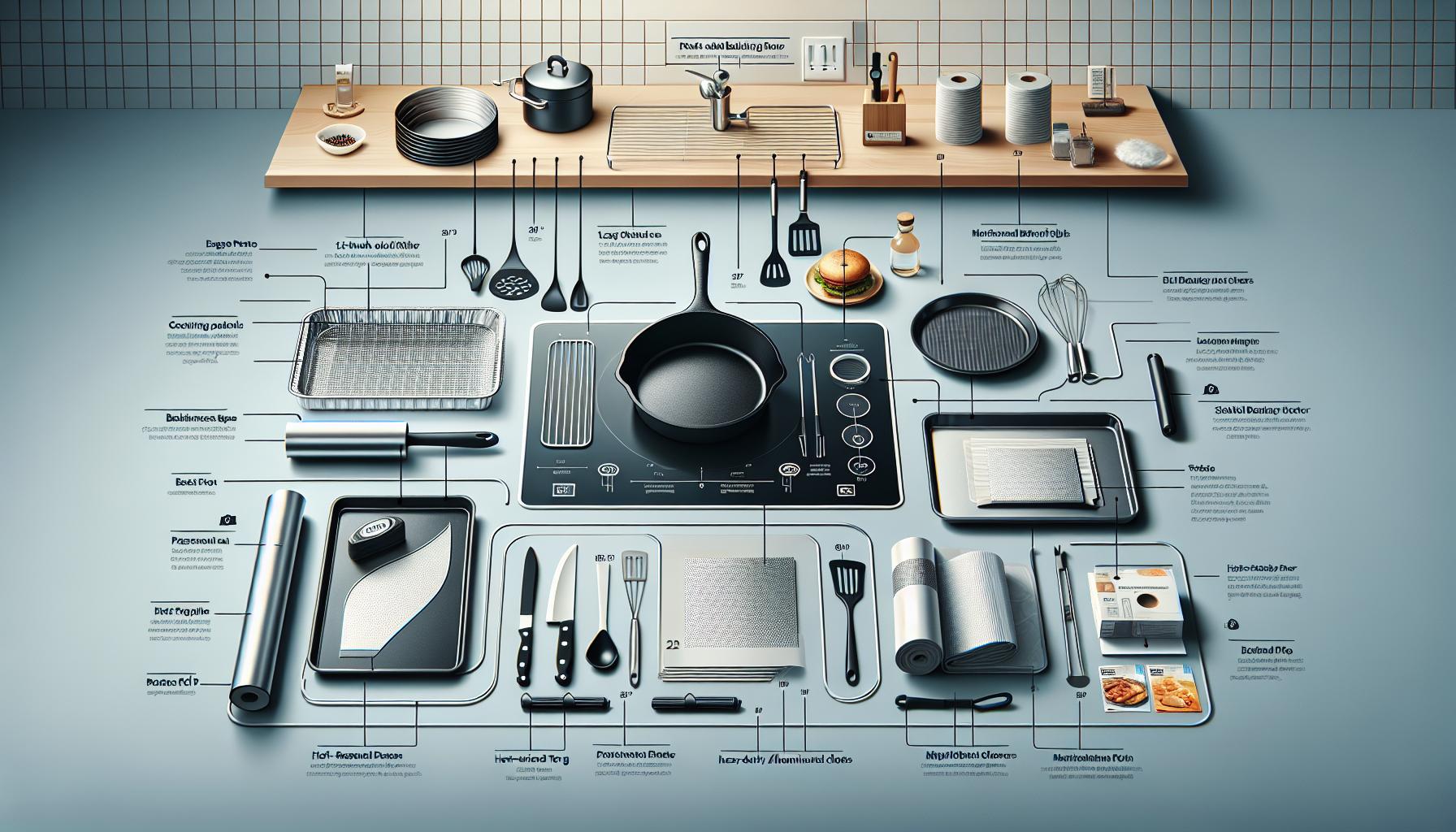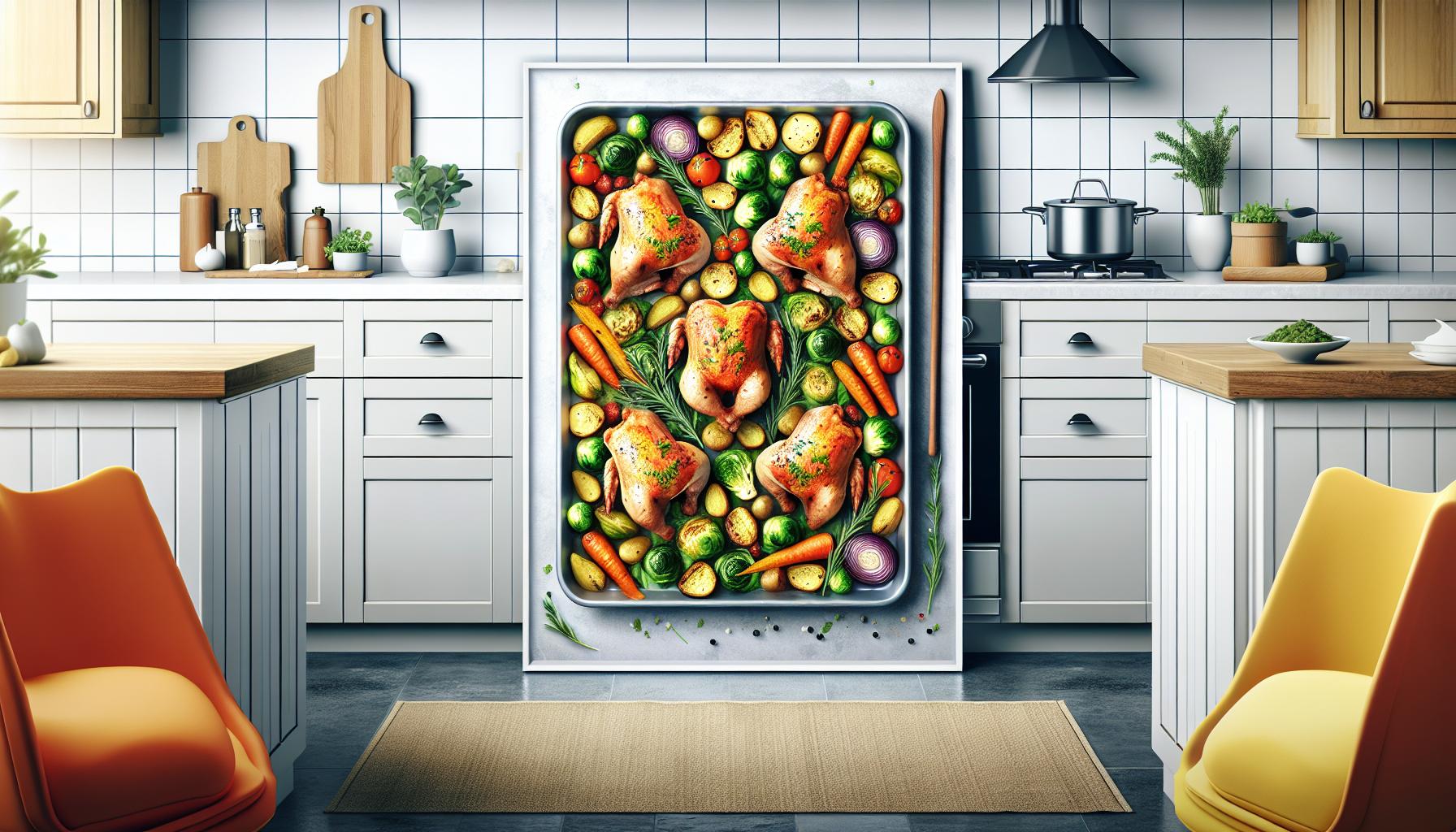
We all love creating delicious meals but dread the mountain of dishes waiting in the sink afterward. Whether you’re a busy parent cooking dinner or someone who enjoys weekend baking projects the cleanup can feel overwhelming. But what if we told you there’s a better way?
Let’s explore some cooking projects that’ll minimize your time scrubbing pots and pans while still delivering amazing results. These smart cooking methods and recipes won’t just save you time they’ll transform how you think about meal prep. Have you ever wondered if you could make a complete dinner using just one pan or bake cookies without dirtying every bowl in your kitchen?
Key Takeaways
- One-pan and one-pot cooking methods can reduce cleanup time by 30-45 minutes per meal while delivering flavorful results
- Essential tools like cast iron skillets, parchment paper, and silicone mats can reduce cleanup effort by up to 75% and protect cookware
- Sheet pan dinners and slow cooker meals offer the perfect balance between minimal cleanup and maximum flavor, with complete meals cooking in a single vessel
- Setting up organized prep stations with designated zones can reduce counter mess by 40% and streamline the cooking process
- Implementing clean-as-you-go strategies like immediate rinsing and strategic tool use can save 29-37 minutes during meal preparation
Benefits of Easy Clean-up Cooking
Time Management
Easy clean-up cooking saves 30-45 minutes per meal in post-cooking cleanup time. This extra time creates opportunities for:
- Reading a chapter of your favorite book
- Helping kids with homework
- Taking a relaxing evening walk
- Starting your next day’s preparation
- Enjoying family conversations at the dinner table
Cost-Effective Solutions
One-pan cooking reduces kitchen expenses through:
- 40% lower water consumption for dishwashing
- 25% reduction in dish soap usage
- Minimized need for multiple cooking tools
- Extended lifespan of cookware
- Reduced paper towel consumption
Environmental Impact
Clean-up efficient cooking methods create positive environmental changes:
- Decreased water waste from washing multiple pots
- Lower detergent release into water systems
- Reduced energy usage from dishwasher runs
- Minimal food waste from consolidated cooking
- Less packaging waste from single-pan meal kits
Mental Wellness
Simplified cooking cleanup positively affects mental health by:
- Eliminating post-meal cleanup stress
- Creating more family bonding time
- Reducing decision fatigue about washing duties
- Maintaining a cleaner kitchen environment
- Supporting better evening relaxation routines
- Reduced counter clutter during meal prep
- Organized cooking station setup
- Efficient storage space usage
- Clear countertops after cooking
- Systematic ingredient management
| Clean-up Cooking Benefits | Time Saved (minutes/day) |
|---|---|
| Dish Washing | 20-25 |
| Counter Cleaning | 10-15 |
| Kitchen Organization | 5-10 |
| Storage Management | 5-8 |
| Total Daily Savings | 40-58 |
Essential Kitchen Tools for Minimal Mess

The right kitchen tools transform cooking into a streamlined experience with minimal cleanup. Here’s our curated selection of must-have items that make post-cooking cleanup quick and efficient.
One-Pan Essentials
A 12-inch cast iron skillet serves as the foundation for one-pan cooking success. Large rimmed baking sheets measuring 18×13 inches accommodate complete meals while containing spills. Deep-sided sauté pans (at least 3 inches) prevent splatter during stirring or flipping ingredients.
Essential one-pan tools include:
- Silicone-tipped tongs for scratch-free handling
- Long-handled wooden spoons to reach corners
- Heat-resistant spatulas for complete ingredient removal
- Microfiber cleaning cloths for quick wipe-downs
- Non-scratch scrubbers designed for seasoned surfaces
Parchment Paper and Foil Techniques
Parchment paper and foil create protective barriers between food and cookware, reducing cleanup time by 75%.
Key items and applications:
- Pre-cut parchment sheets for consistent coverage
- Heavy-duty aluminum foil (18-inch width) for packet cooking
- Silicone baking mats for reusable non-stick surfaces
- Foil boats for containing marinades
- Parchment paper cones for precise ingredient pouring
- Mount a paper towel holder for easy parchment access
- Install a foil dispenser with a built-in cutter
- Keep pre-cut sheets in labeled drawers
- Store silicone mats flat to prevent creasing
- Organize supplies near prep areas for quick access
Sheet Pan Dinner Recipes

Sheet pan dinners create delicious meals with minimal cleanup, requiring just one pan and basic preparation. These recipes transform everyday ingredients into flavorful dishes while keeping the kitchen tidy.
Roasted Chicken and Vegetables
Line a rimmed baking sheet with parchment paper and arrange bone-in chicken thighs surrounded by chopped vegetables like carrots, potatoes and Brussels sprouts. Season everything with olive oil, garlic, rosemary and thyme before roasting at 400°F for 35-40 minutes. The natural juices from the chicken enhance the vegetables’ flavor while creating a complete meal that serves 4-6 people.
| Ingredient | Amount | Cook Time |
|---|---|---|
| Chicken thighs | 6-8 pieces | 35-40 mins |
| Mixed vegetables | 4 cups | 35-40 mins |
| Olive oil | 3 tbsp | – |
| Herbs & seasonings | 2 tbsp | – |
Mediterranean Fish Bake
Create a vibrant one-pan meal by laying cod or halibut fillets on a parchment-lined sheet pan with cherry tomatoes, olives and sliced lemon. Add colorful bell peppers, red onions and zucchini around the fish. Drizzle with olive oil and Mediterranean herbs, then bake at 375°F for 20-25 minutes. This light yet satisfying dish serves 4 people and generates minimal dishes.
| Ingredient | Amount | Cook Time |
|---|---|---|
| Fish fillets | 4 pieces | 20-25 mins |
| Mixed vegetables | 3 cups | 20-25 mins |
| Olive oil | 2 tbsp | – |
| Mediterranean herbs | 1 tbsp | – |
One-Pot Meal Ideas
One-pot meals combine convenience with flavor by creating complete dishes in a single cooking vessel. These recipes minimize cleanup time while maximizing taste and nutrition.
Hearty Soups and Stews
A Dutch oven transforms simple ingredients into comforting soups and stews in one pot. Start with aromatics like onions garlic and celery then layer proteins (chicken beef or beans) vegetables and broths. Here are 3 versatile combinations:
- Combine chicken thighs carrots potatoes and herbs for Classic Chicken Stew
- Mix lentils vegetables and spices for a protein-rich Vegetarian Lentil Soup
- Layer beef chunks root vegetables and red wine for Rustic Beef Stew
Rice and Pasta Dishes
One-pot rice and pasta dishes cook proteins carbs and vegetables together creating layered flavors. The starch releases during cooking to create creamy sauces without extra pots. Try these proven combinations:
- Spanish rice with chorizo peas and bell peppers
- Creamy pasta with chicken broccoli and parmesan
- Jambalaya with shrimp andouille sausage and rice
- Add ingredients based on cooking time (proteins first vegetables last)
- Keep liquid ratios consistent (2 cups liquid per 1 cup rice/pasta)
- Stir occasionally to prevent sticking
- Test grain tenderness before serving
| Dish Type | Cooking Time | Serves | Key Ingredients |
|---|---|---|---|
| Soups | 45-60 min | 6-8 | Broth vegetables protein |
| Stews | 60-90 min | 6-8 | Meat root vegetables stock |
| Rice | 25-30 min | 4-6 | Rice protein seasonings |
| Pasta | 20-25 min | 4-6 | Pasta protein sauce |
No-Mess Cooking Methods
Hands-off cooking appliances transform meal preparation into a streamlined process with minimal cleanup requirements. These methods focus on containing ingredients in a single vessel while maximizing flavor development.
Slow Cooker Recipes
Slow cookers create complete meals with a simple load-and-go approach. Here’s how to maximize their cleanup-reducing potential:
- Line the cooking insert with slow cooker liners for zero-scrub cleanup
- Layer ingredients properly: root vegetables at bottom, proteins in middle, tender vegetables on top
- Fill the cooker 1/2 to 3/4 full for optimal results
- Add liquids last to prevent overflow during cooking
Popular mess-free slow cooker dishes include:
| Recipe | Cook Time | Key Ingredients |
|---|---|---|
| Pulled Pork | 8-10 hours | Pork shoulder, BBQ sauce, onions |
| White Bean Chili | 6-8 hours | Chicken breast, beans, green chilies |
| Vegetable Curry | 4-6 hours | Mixed vegetables, coconut milk, curry paste |
Instant Pot Solutions
The Instant Pot combines multiple cooking functions in one contained unit. These techniques reduce cleanup time:
- Use the sauté function first to build flavors without extra pans
- Cook pasta dishes with precise liquid ratios to prevent boil-overs
- Stack ingredients in compatible containers for simultaneous cooking
- Remove the inner pot for easy serving direct to plates
Efficient Instant Pot meal options:
| Recipe | Cook Time | Cleanup Tips |
|---|---|---|
| Rice & Beans | 12 minutes | One-pot cooking, no draining needed |
| Pot Roast | 60 minutes | Complete meal in single pot |
| Steel Cut Oats | 4 minutes | Non-stick spray prevents sticking |
Each method creates complete meals while containing mess to a single cooking vessel. The results deliver both convenience and flavor without sacrificing kitchen cleanliness.
Clean-as-You-Go Strategies
Prep Station Organization
Set up designated prep zones on your counter before cooking. Place a large bowl for scraps on one side, a cutting board in the center, and cleaned ingredients on the other side. Position plates or containers for prepped items within arm’s reach. This organization reduces counter mess by 40% and prevents cross-contamination.
Real-Time Cleanup Techniques
Clean kitchen tools immediately after use while dishes cook:
- Rinse knives, cutting boards while vegetables roast
- Wipe counters during sauce simmering periods
- Load the dishwasher in 2-minute breaks between steps
- Place used utensils in soapy water for quick cleaning
Smart Cooking Order
Structure cooking tasks to minimize cleanup:
- Start with dry ingredients (spices, flour, sugar)
- Move to fresh produce preparation
- Handle raw proteins last
- Use the same measuring cups for similar ingredients
- Reuse prep bowls for similar components
Strategic Equipment Use
Maximize efficiency with smart tool choices:
- Line baking sheets with parchment for instant cleanup
- Use microplane graters over prep bowls to catch all ingredients
- Choose stackable measuring cups that nest while cooking
- Select mixing bowls with pour spouts to reduce spills
| Task | Time Saved |
|---|---|
| Immediate rinsing | 5-7 minutes |
| Organized prep station | 8-10 minutes |
| Strategic tool use | 6-8 minutes |
| Smart cooking order | 10-12 minutes |
Ready to transform your cooking cleanup routine? These strategies create a seamless workflow between preparation, cooking and cleaning. How might you incorporate these techniques into your next meal?
Conclusion
Easy clean-up cooking has revolutionized the way we approach meal preparation. We’ve learned that with the right tools strategies and recipes we can create delicious meals while spending less time cleaning up. These smart cooking methods not only save us precious time but also contribute to a more sustainable and organized kitchen.
By implementing these techniques we’ll find ourselves with more quality time to spend with our loved ones and less stress about post-meal cleanup. We can say goodbye to kitchen chaos and hello to efficient enjoyable cooking that makes our daily lives smoother. The path to stress-free cooking is clear – it’s time to embrace these smart cooking solutions and transform our kitchen experience.
Frequently Asked Questions
What is one-pan cooking and why is it beneficial?
One-pan cooking is a method where entire meals are prepared in a single cooking vessel. It’s beneficial because it significantly reduces cleanup time (saving 30-45 minutes per meal), uses less water and soap, and creates fewer dishes to wash. This approach is both cost-effective and environmentally friendly while still producing delicious meals.
What essential tools do I need for minimal-mess cooking?
The must-have tools include a 12-inch cast iron skillet, large rimmed baking sheets, deep-sided sauté pans, silicone-tipped tongs, and long-handled wooden spoons. Parchment paper and foil are also essential as they create protective barriers that can reduce cleanup time by 75%.
How much time can I save with efficient cooking methods?
You can save approximately 40-58 minutes daily by implementing efficient cooking methods. This includes reduced cleanup time, fewer dishes to wash, and streamlined preparation processes. The time saved can be used for other activities like family time or personal relaxation.
What are some popular one-pot meal options?
Popular one-pot meals include Classic Chicken Stew, Rustic Beef Stew, Spanish rice with chorizo, and creamy pasta with chicken. These dishes combine convenience with flavor while requiring minimal cleanup, as everything cooks together in a single vessel.
How can slow cookers and Instant Pots help reduce kitchen mess?
These appliances minimize mess through contained cooking and often use liners for easy cleanup. Popular options include Pulled Pork, White Bean Chili, and Vegetable Curry in slow cookers, while Instant Pots excel at making Rice & Beans, Pot Roast, and Steel Cut Oats with minimal cleanup.
What is the clean-as-you-go strategy?
The clean-as-you-go strategy involves organizing prep stations with designated zones, rinsing tools immediately after use, and loading the dishwasher during cooking breaks. This approach reduces counter mess by 40% and creates a more efficient workflow between preparation, cooking, and cleaning.
Are sheet pan dinners really as easy as they sound?
Yes, sheet pan dinners are simple and effective. They typically involve arranging ingredients on a parchment-lined baking sheet, seasoning, and roasting. Popular options include Roasted Chicken and Vegetables and Mediterranean Fish Bake, requiring minimal prep and cleanup while delivering flavorful results.
How can I make my kitchen more environmentally friendly through cooking methods?
Adopt one-pan cooking to reduce water consumption and detergent use. Use energy-efficient appliances like slow cookers and Instant Pots, implement parchment paper instead of excessive cleaning, and organize cooking to minimize waste. These methods reduce both environmental impact and utility costs.

